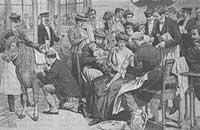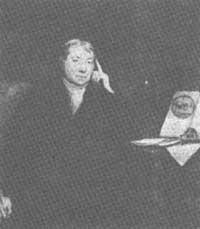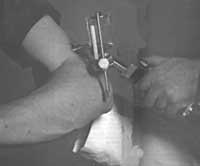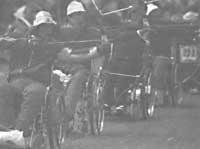Insertion
Vaccination is the means used by medicine to prevent infection diseases. Name Pasteur proposed, in tribute to Jenner, for the work done by this English physician on smallpox vaccination. Vaccination involves the introduction into the body of men or animals of substances called antigens (usually viruses, bacteria or their toxins). The pathways used are oral, cutaneous, schematic, or injection route, usually. The charreo produces a series of reactions in the body that result in resistance or resistance to a certain disease. It can be total or partial and final or provisional. This situation of resistance is called immunity, which means free or exempt. Nowadays, however, the concept of pot has spread and other topics are used as antigen.
Nacedero of the Txerdos

The origin and name of vaccination are directly related to the disease known as smallpox. This disease, which fortunately could be considered missing today, was a very serious disease, which has appeared in all regions and times. Chinese In the 11th century and in Greece. It was already described in the year 400.
The disease appeared as an epidemic. Their mortality was enormous and those who were cured (that is, those who survived) were left with the face full of great scars and in many cases blind.
The improvement of B i z i - b a l d i n t z e n, proper hygiene and, above all, vaccination have made this disease disappear. On October 26, 1979, Ali Maow Maolin, a young Somali, the last marginalized in the world, was curated. The disappearance of Baztanga was proclaimed on 8 May 1980 at the Health Assembly held in Geneva worldwide.
The latest cases in Europe have been caused by laboratory accidents, causing infections in small groups of people in the area (family members, co-workers), as happened in Liverpool in 1946, in London in 1973 and in Birminghan in 1978.
On the other hand, the last epidemic, although relatively small, took place in Yugoslavia, where in 1971 175 people were ill (of which 35 died). The disease was caused by a Muslim priest returning from a pilgrimage to the sacred cities of Mecca and Medina and spread as he passed through Iran. Shortly before arriving at his residence in Yugoslavia he became ill.
The disease was not initially diagnosed or contaminated, so isolation should not be the same. Once the disease was diagnosed, appropriate measures were taken and 18 million of a population of 22 million were incorporated in 3 weeks. The priest was vaccinated and after suffering a mild illness he was healed. The possible integration made diagnosis difficult.
Faced with this serious disease, humans of yesteryear used various measures to prevent it. The Chinese blew in the nostrils the dust of the scales of the sick.
Lady Mary Wortley Montdugu, wife of the Ambassador of England to Turkey, introduced in her hometown the method she saw in the East, in 1717, to avoid the disease: in the arm an axal incision was made through which they passed a wet thread in the servitude of a thorn.
This experience was successful in 6 people sentenced to death and the procedure spread throughout England and around the world. There were doctors willing to do this and one of them, the cuaquero doctor Thomas Dimsdale, who called the Empress Catherine of Russia to perform the inoculation of the Baztanese madness to him and his family.

This operation was carried out successfully, and was subsequently repeated to another 200 people from Moscow and St. Petersburg. Despite the individual success of this activity, he was not able to avoid the mortality of the disease or its extension.
Years later it was Edward Jenner (1749-1823) who proposed a new system that has reached our days with all the novelties and improvements that have been produced. His success has been so great that we can consider this doctor as one of the great benefactors of Humanity.
On one occasion he heard a milkman saying: "I will never suffer a bad nose (smallpox), because I have already suffered the cows (cowpox)". This last disease is only a skin infection of the udders of cows, which is transmitted from time to time by the milk milker. It causes skin disease in people with pustules and a little febrile. This disease is known as a vaccine, and its name has persisted.
After twenty years of study and reflection on this subject, Jenner decided to put it into practice. And so, on May 14, 1796, James Phipps, an 8-year-old boy, Sara Nelmes, was inoculated with a fortune taken from the hand of Sara Nelmes, the milkwoman who suffered from the smallpox of cows. Eight weeks later he inoculated the child with the pox pus and the disease did not appear.
The procedure was immediately expanded, with increasingly purified outbreaks and vaccination in some villages became mandatory or mandatory. With the eradication of the disease vaccination has also been interrupted, and at this time the viruses are kept in some crops (less and less) in adequate cultural means.
There are those who say that all these viruses should be completely destroyed, while others are in favour of keeping a small reserve if we consider the possibility of some isolated case in the deserts of Africa or in the deep jungles of South America, even if it is very small.
Bacteria and viruses
Pasteur and his time begin a new era of medicine: the era of bacteria and viruses.
Louis Pasteur (1822-1895), a French chemist born in Dolle, a small town in Jura, although he never studied medicine, became one of the most outstanding figures in the history of medicine. Living in the region of Lille, it was a region dedicated to vinification, which for a long time researched the causes of fermentation and rot of matter. He showed that these processes were due to small microorganisms. Where did these microorganisms come from? They did not appear for their own generation and could be found in the atmosphere.
The action of microorganisms was cancelled by heat, since germs were destroyed: this procedure has been called pasteurization since then. Based on this discovery, Lister applied the principles of asepsy and antisepsis in surgery, obtaining surprising and very brilliant conclusions.

Pasteur, after solving the problems caused by a Lyon cetane disease, tried to treat the anthrax or mole along the road marked by Jenner. This disease caused great disasters and losses in the bovine and sheep cabins. Pasteur successfully inoculated a attenuated strain of the virus obtained from an old crop. Subsequently, he also treated the cholera of hens, which introduced them as a preventive form. In this way he obtained very good conclusions.
However, his most famous discovery was obtained on July 6, 1885, with a vaccine prepared in his laboratory, bitten by a rabid dog when he treated and cured the child Joseph Meister. Months later, he saved a friend and cured a horned shepherd while struggling with a rabid dog.
Pasteur concluded that the rabies virus is based in nerve centers. With the bone marrow he obtained a attenuated virus that he used in his vaccinations. Vaccines currently used are prepared with viruses grown in different media:
- Nervous tissue (sheep, goats, rabbit). They can cause brain reactions. Embryonic nerve tissue. They produce good immunity and less reaction. Vaccines obtained by cultivating the virus in the duck embryo. Immunity is not so good, but they are supported much more.
- In recent times human cells are used as a culture medium, and vaccines prepared by this route are the most resistant, and their immune power is very high.
The healing effects are not entirely satisfactory, so vaccination is carried out in conjunction with human rabies gammaglobulin. This gammaglobulin contains many antibodies to the rabies virus.
After the discoveries of Pasteur, researchers (some of whom had been students of Pasteur, others did not) worked in laboratories, especially in Germany and France, which gave a great boost to medicine, discovering bacteria and viruses that produced many known diseases for years.
The best known is Robert Koch, who may be able to discuss with Pasteur the title of being the father of Bacteriology. This researcher was the bacillus of tuberculosis (later known as Koche bacillus) and discovered that of cholera, without forgetting many other valuable scientific and medical work done.
Metchnikoff, Roux and Vidal, former students of Pasteur, brought new knowledge to emerging science.
Von Bering, discoverer of suerotherapy and tetanus anatoxin. Kitasato and Yersin discovered at the same time the pesto bacillus, Loefler diphtheria, Hansen legend, Pfeiffer influenza, etc. These and then the XIX. late 20th century Many others who have followed throughout the 20th century have complemented our current knowledge of bacteria and viruses.

More than one of these sages lost their lives in their research: Noguchy died with yellow fever while researching this disease, and Daniel Carrion, in 1881, found death after autoinoculating the Peruvian wart in the works of identification and study of this disease that occurs in the tropical nations of South America, called Droya Fever. In their laboratories, these scholars managed to isolate and cultivate these germs, modifying them at the same time (cushioning them or killing them in order to remove their toxins). New vaccines were obtained (Figure 1).
What is the vaccine?
Vaccination is just an immune reaction similar to that carried out by the human or animal body when it introduces and assaults a virus, bacteria, toxin, or other foreign body.
This immune reaction, although not complete, largely corresponds to lymphocytes, cellular elements found in the blood.
The so-called T lymphocytes are activated at the same time as the attack and from them derives cellular immunity. Its evaluation, not so simple, is achieved by specific biological tests.
So-called B lymphocytes reach the site of the attack and produce proteins called gammaglobulins that neutralize viruses and bacteria. At a later stage, cell enzymes liserize and destroy these lymphocytes. In some cases, some of these lymphocytes are memorized for years, and if a new aggression of the same aggressor occurs, they respond immediately through the new and abundant production of the same specific antibodies. This requires the body to have the immune system complete.
Vaccine training and administration
Numerous laboratories around the world work on the preparation of new vaccines and the improvement of existing ones, with the aim of reducing the morbidity and mortality of so-called infectious diseases. The aim of the application of vaccines is to achieve as complete and persistent immunity as possible and minimize the adverse effects that may occur. In some cases the mild disease that occurs should not be contagious, that is, it should not spread to the people around it.
Vaccination uses viruses, bacteria, toxins from these and much lower frequency antigens. All these substances must be properly modified to achieve better effects. Viruses and bacteria are used alive (but attenuated), inactivated or dead. Toxins change by eliminating their virulence and intensity.
* Live attenuated vaccines
The biggest problem these vaccines have is that they can become safe. The ideal would be to create a light or almost invisible paving.
Viruses or bacteria cushion the weight of the pool by cultivating them in different means. In short, stable mutated strains have lost their virulence and enviability.
In the cultures of the tuberculous bacillus, the gallbladder is added, which acts as an inhibiting substance, obtaining the BCG tuberculosis vaccine after several crops. This BCG is the only live bacterial vaccine used in humans and its immunity is cellular.

The risk of these vaccines that has been demonstrated is virus contamination in cultural media. For example, yellow fever vaccination caused 25,585 cases of hepatitis in a U.S. military camp in 1942. Hepatitis was not caused by the yellow fever virus, but by the hepatitis virus that was found in a small number of serums that were added to get the vaccine attenuation.
In the preparation of live attenuated vaccines, animal cell cultures are used and occasionally the viruses present in these crops contaminate vaccines. A serious accident occurred in the laboratory in the German town of Marburg in 1967. In this laboratory monkey tissues were cultivated and a serious infection appeared that affected all laboratory personnel, causing fever, exanthemas and bleeding: mortality increased by up to 30%. They managed to isolate the virus that caused the disease, known since then as Marburg virus.
The SV-5 virus has been found in mono kidney cells used to obtain vaccines. This virus hardly has pathogenic action for the cell. From this point of view oncogenic viruses are more important: one of them, called SV-40, often appears also in these monkey cells, and they have also been found regularly in the polar vaccine.
When the culture medium is the egg or embryo of the chicken, the vaccine can be spread by the leukosis bird virus or by the Roux chicken sarcoma virus. These contaminations, however, have occurred very rarely and currently do not appear, as new techniques allow us to detect and identify this type of virus.
What is the goal of attenuated germ vaccination? Occurrence of a small infection in the vaccinated person. In this way the viruses reproduce inside and in a few days the number of antigens increases. This allows for a better immune response and better development of antibodies so that immunity is long lasting, similar to that produced by natural infection
Measles, rubella, parotiditis and polio vaccines are of this type. The first, the measles vaccine, occasionally produces at 8 days a mild disease, similar to that of a measles and that is not contaminated.
* Inactive vaccines
Live germs are inactivated by physical or chemical means. Among the physical means heat is the most used and to a lesser extent ultraviolet rays. The most commonly used chemicals are formaldehyde, phenol and acetone to achieve greater stability by adding some case of mercury.They are prepared with whole or partial germ (usually capsule). Why only the capsule? The necessary antigen is considered to be in capsule.
To increase the immunizing power of vaccines are added substances such as mineral salts, aluminum hydroxide, phosphate and aluminum sulfate, calcium phosphate, etc. These substances add antigenic stimulation. Oily substances can also be used to increase immunization power (these substances are used only in veterinarians, as they are not tolerated very well and are also considered potentially carcinogenic). Bacterial components, or even very dead bacteria, are used as they are believed to increase the production of antibodies.
These types of vaccines include whooping cough, cholera and intestinal fever in bacteria, and in the case of vials, flu, yellow fever, and the Salk-type injectable polio vaccine, which is currently barely used.
Vaccine inactivation, vaccination with these months is less effective, shorter, and requires commemorative doses that periodically reinforce immunity. Immunity is not cellular, but humoral, with the formation of specific antibodies.
Diphtheria and tetanus vaccines are prepared with bacilli toxins, once transformed and inactivated by formaldehyde. These vaccines are called ANATOXINS.
- 1771- Variolization extends throughout England.
- 1798- Jenner publishes her work on the vaccine. 1885-Rabies vaccine of cakes.
- 1892- Cholera vaccine (HAFFKIN).
- 1898- Vaccine against intestinal fever, typhoid (WRIGHT).
- 1913- Immummization against diphtheria, toxin-antitoxin (BEHRING).
- 1921- BCG vaccine (CALMETTE and GUERIN).
- 1923- Tetargo toxoide ( RAMON and GLENNY). Antimaluz (MADSEN)
- 1937- First flu vaccine. Yellow fever vaccine. 17.D ( THEILER).
- 1949- Vaccine against parouditis. ENDERS and dinners cultivate polio virus.
- 1954- Cushioned polar vaccine (SALK).
- 1957- Attenuated vaccine against the vocal pole ( SABIN).
- 1960- Measles vaccine ( ENDERS).
- 1962- Rubella vaccine (WELLER).
- 1968- Meningococcal vaccine type C.
- 1971- Meningococcal vaccine type A.
- 1979- Hepatitis B vaccine.
- 1979- It is considered missing and recommended (eliminated). the back vaccine is not





